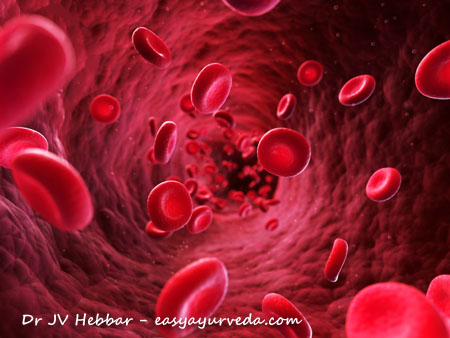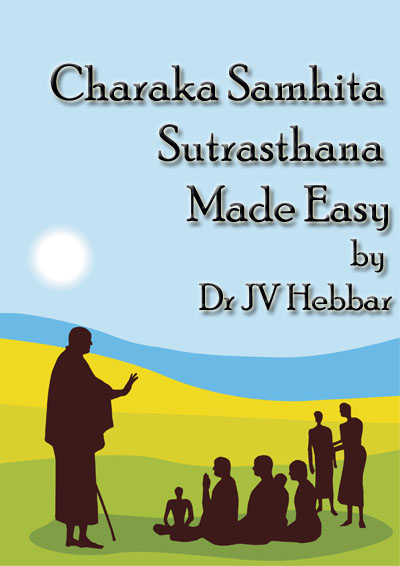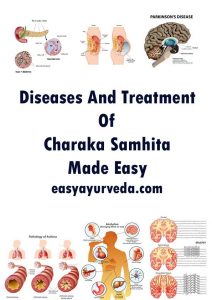24th chapter of Charaka Samhita Sutrasthana – Vidhi Shoniteeya Adhyaya
Blood is explained as the reason for life, strength and immunity in Ayurveda. How is it produced? What are its functions? What causes blood impurity? What are diseases that result? How to treat this? These aspects are explained in detail in the 24th chapter of Charaka Samhita Sutrasthana – Vidhi Shoniteeya Adhyaya (Shonita and rakta means blood).

Table of Contents
Factors responsible for Blood Formation
Factors responsible for normal Haemopoiesis (Blood production):
विधिना शोणितं जातं शुद्धं भवति देहिनाम्|
देशकालौकसात्म्यानां विधिर्यः सम्प्रकाशितः||३||
vidhinā śoṇitaṃ jātaṃ śuddhaṃ bhavati dehinām|
deśakālaukasātmyānāṃ vidhiryaḥ samprakāśitaḥ||3||
By the administration of proper regimen, with due regard to the place, time and habit as described in the sixth chapter of this section, pure blood is formed in human beings.[3]
Function of normal blood
तद्विशुद्धं हि रुधिरं बलवर्णसुखायुषा|
युनक्ति प्राणिनं प्राणः शोणितं ह्यनुवर्तते||४||
tadviśuddhaṃ hi rudhiraṃ balavarṇasukhāyuṣā|
yunakti prāṇinaṃ prāṇaḥ śoṇitaṃ hyanuvartate||4||
Living creatures are endowed with
Bala– strength and immunity,
Varna– skin complexion
Sukha – happiness, comfort
Ayusha – longevity due to pure blood.
Blood plays a vital role in the sustenance of Vital force of life [4]
Causes for blood impurity
प्रदुष्टबहुतीक्ष्णोष्णैर्मद्यैरन्यैश्च तद्विधैः|
तथाऽतिलवणक्षारैरम्लैः कटुभिरेव च||५||
कुलत्थमाषनिष्पावतिलतैलनिषेवणैः|
पिण्डालुमूलकादीनां हरितानां च सर्वशः||६||
जलजानूपबैलानां प्रसहानां च सेवनात्|
दध्यम्लमस्तुसुक्तानां सुरासौवीरकस्य च||७||
विरुद्धानामुपक्लिन्नपूतीनां भक्षणेन च|
praduṣṭabahutīkṣṇoṣṇairmadyairanyaiśca tadvidhaiḥ|
tathā’tilavaṇakṣārairamlaiḥ kaṭubhireva ca||5||
kulatthamāṣaniṣpāvatilatailaniṣevaṇaiḥ|
piṇḍālumūlakādīnāṃ haritānāṃ ca sarvaśaḥ||6||
jalajānūpabailānāṃ prasahānāṃ ca sevanāt|
dadhyamlamastusuktānāṃ surāsauvīrakasya ca||7||
viruddhānāmupaklinnapūtīnāṃ bhakṣaṇena ca|
Food that cause Blood Impurity
a. Unwholesome, hot and sharp (teekshna) wine and food in large quantity (bahala)
b. Ati Lavana Amla Kshara Katu – Excessive saline, sour, alkaline, acidic and pungent food
c. Kulattha (horse gram), Masha (black gram), Nishpava (flat bean) and sesame oil
d. Pindalu (Dioscorea Alata Linn (Water yam) /Moonseed plant / Tamilnadia uliginosa), radish, and all green eatables
e. Meat of aquatic (Jalaja), marshy (Anupa) and Prasaha (living beings which catch food by teeth, tear and eat) types of animal and animals living in holes (Bileshaya)
f. Curd, sour whey (Amla mastu), vinegar (Sukta), wine (Sura), and Sauviraka type of liquor
g. Rotten (Upaklinna), putrefied food articles (Pooti) and those having bad food combinations and
h. Any other type of food in excessive quantity.
Blood Impurity Reasons
Activities that cause impure blood:
भुक्त्वा दिवा प्रस्वपतां द्रवस्निग्धगुरूणि च||८||
अत्यादानं तथा क्रोधं भजतां चातपानलौ|
छर्दिवेगप्रतीघातात् काले चानवसेचनात्||९||
श्रमाभिघातसन्तापैरजीर्णाध्यशनैस्तथा|
शरत्कालस्वभावाच्च शोणितं सम्प्रदुष्यति||१०||
bhuktvā divā prasvapatāṃ dravasnigdhagurūṇi ca||8||
atyādānaṃ tathā krodhaṃ bhajatāṃ cātapānalau|
chardivegapratīghātāt kāle cānavasecanāt||9||
śramābhighātasantāpairajīrṇādhyaśanaistathā|
śaratkālasvabhāvācca śoṇitaṃ sampraduṣyati||10||
a. Sleeping during day time after taking liquid, oily and heavy food
b. Excessive anger, excessive exposure to the sun and fire
c. Suppression of the urge for vomiting
d. Absence of blood-letting therapy (in the autumn – Sharat Ritu)
e. Exertion, external injury, heat, taking food before the previous meal is digested
f. By the very nature of the autumn season – Sharat Ritu. [5-10]
Diseases caused by vitiated blood
ततः शोणितजा रोगाः प्रजायन्ते पृथग्विधाः|
मुखपाकोऽक्षिरागश्च पूतिघ्राणास्यगन्धिता||११||
गुल्मोपकुशवीसर्परक्तपित्तप्रमीलकाः|
विद्रधी रक्तमेहश्च प्रदरो वातशोणितम्||१२||
वैवर्ण्यमग्निसादश्च पिपासा गुरुगात्रता|
सन्तापश्चातिदौर्बल्यमरुचिः शिरसश्च रुक्||१३||
विदाहश्चान्नपानस्य तिक्ताम्लोद्गिरणं क्लमः|
क्रोधप्रचुरता बुद्धेः सम्मोहो लवणास्यता||१४||
स्वेदः शरीरदौर्गन्ध्यं मदः कम्पः स्वरक्षयः|
तन्द्रानिद्रातियोगश्च तमसश्चातिदर्शनम्||१५||
कण्ड्वरुःकोठपिडकाकुष्ठचर्मदलादयः|
विकाराः सर्व एवैते विज्ञेयाः शोणिताश्रयाः||१६||
tataḥ śoṇitajā rogāḥ prajāyante pṛthagvidhāḥ|
mukhapāko’kṣirāgaśca pūtighrāṇāsyagandhitā||11||
gulmopakuśavīsarparaktapittapramīlakāḥ|
vidradhī raktamehaśca pradaro vātaśoṇitam||12||
vaivarṇyamagnisādaśca pipāsā gurugātratā|
santāpaścātidaurbalyamaruciḥ śirasaśca ruk||13||
vidāhaścānnapānasya tiktāmlodgiraṇaṃ klamaḥ|
krodhapracuratā buddheḥ sammoho lavaṇāsyatā||14||
svedaḥ śarīradaurgandhyaṃ madaḥ kampaḥ svarakṣayaḥ|
tandrānidrātiyogaśca tamasaścātidarśanam||15||
kaṇḍvaruḥkoṭhapiḍakākuṣṭhacarmadalādayaḥ|
vikārāḥ sarva evaite vijñeyāḥ śoṇitāśrayāḥ||16||
The following diseases occur due to the vitiation of blood:
Mukhapaka – Stomatitis,
Akshiraga – conjunctivitis,
Pooti ghrana – rhinitis,
Asya Gandhita – foul odor from mouth,
Gulma – abdominal tumor,
Upakusha – type of mouth diseases,
Visarpa – a skin diseases characterizes by an acute spread,
Raktapitta – a diseases characterized by bleeding from different parts of the body,
Prameelaka – drowsiness,
Vidradhi – abscess,
Raktameha – hematuria, blood in urine,
Pradara – menorrhagia,
Vata Shonita – gout,
Vaivarnya – Palor,
Agnisada – Suppression of the power of digestion,
Pipasa – thirst,
Guru Gatrata – heaviness of the body,
Santapa – burning sensation,
Ati daurbalya – excessive weakness,
Aruchi – anorexia,
Shiro Ruk – headache,
Vidaha – internal burning sensation
Tikta Amla Udgirana – bitter sour eructation specially of the diet and drink that are not properly digested,
Klama – tiredness,
Krodha – excessive anger,
Sammoha – bewilderment,
Lavanasyata – saline taste in mouth,
Sveda – excessive sweating, foul smell of the body,
Mada – intoxication, shivering,
Svara Kshaya – aphonia,
drowsiness (Tandra), excessive sleep,
Tamo Darshana – frequent attack of fainting,
pruritis (Kandu), eruption (Kota), urticaria, pimples, skin diseases, Charmadala (skaling), etc.
Differential Diagnosis
Differential diagnosis criteria for disorders due to blood vitiation:
शीतोष्णस्निग्धरूक्षाद्यैरुपक्रान्ताश्च ये गदाः|
सम्यक् साध्या न सिध्यन्ति रक्तजांस्तान् विभावयेत्||१७||
śītoṣṇasnigdharūkṣādyairupakrāntāśca ye gadāḥ|
samyak sādhyā na sidhyanti raktajāṃstān vibhāvayet||17||
If any curable disease does not get cured by cold, hot, unctuous (oily), drying and such other therapies, they are to be taken as diseases due to the vitiation of blood.
In case of Rakta borne disorders, if the disease looks Sadhya (possible to cure), but does not respond well to :
Sheeta upachara – cold treatment (such as cold water bath, exposure to moon, cold wind, coolant medicines such as chandanadi kashaya, dhanyaka hima (coriander cold infusion) etc.)
Ushna – hot treatment (such as sweating) – such as spices, hot decoctions, hot water consumption, hot water bath etc.
Snigdha Upachara – fat and oleation treatment – internal and external
Rooksha Upachara – roughness increasing treatment such as powder massage, triphala churna, cow urine therapy etc.
If Rakta disorders which look easy to cure, but still, if they do not respond to cold, hot, unctuous or dry treatments, then such disorders should be considered as asadhya – impossible to cure.
Treatment principles
Principles of treatment for the diseases of blood:
कुर्याच्छोणितरोगेषु रक्तपित्तहरीं क्रियाम्|
विरेकमुपवासं च स्रावणं शोणितस्य च||१८||
kuryācchoṇitarogeṣu raktapittaharīṃ kriyām|
virekamupavāsaṃ ca srāvaṇaṃ śoṇitasya ca||18||
Therapies like purgation, fasting and blood-letting indicated for the treatment of Raktapitta (a disease characterizes by bleeding from different parts of the body) are also useful for curing diseases due to the vitiation of blood.
Caution for blood- letting
Blood-letting is to be done, with due regard to
Bala – the strength of the patient and
Dosha Pramana – nature as well as seriousness of the disease. The quantity of blood that is to be should be commensurate with the purification of blood. [19]
Vitiated Blood Features
Changes in blood due to vitiation of different Doshas:
अरुणाभं भवेद्वाताद्विशदं फेनिलं तनु|
पित्तात् पीतासितं रक्तं स्त्यायत्यौष्ण्याच्चिरेण च||२०||
ईषत्पाण्डु कफाद्दुष्टं पिच्छिलं तन्तुमद्घनम्|
संसृष्टलिङ्गं संसर्गात्त्रिलिङ्गं सान्निपातिकम्||२१||
aruṇābhaṃ bhavedvātādviśadaṃ phenilaṃ tanu|
pittāt pītāsitaṃ raktaṃ styāyatyauṣṇyāccireṇa ca||20||
īṣatpāṇḍu kaphādduṣṭaṃ picchilaṃ tantumadghanam|
saṃsṛṣṭaliṅgaṃ saṃsargāttriliṅgaṃ sānnipātikam||21||
Rakta (blood), vitiated by Vata becomes reddish (Arunabha), non-slimy (Vishada), foamy (Phenila) and thin (Tanu):
Shonita (blood) vitiated by Pitta is yellow (Peeta) and black (Asita), and it takes a longer time to coagulate because of the inherent heat (of Pitta);
Blood vitiated by Kapha is slightly Pale (Pandu) in color, slimy (Picchila), sticky and thick (ghana),
Blood due to vitiation by more than one Dosha shares the characteristics of the respective symptoms of all the vitiated Doshas.[21-22]
Features of pure blood
तपनीयेन्द्रगोपाभं पद्मालक्तकसन्निभम्|
गुञ्जाफलसवर्णं च विशुद्धं विद्धि शोणितम्||२२||
tapanīyendragopābhaṃ padmālaktakasannibham|
guñjāphalasavarṇaṃ ca viśuddhaṃ viddhi śoṇitam||22||
Tapaneeya – Pure blood can be likened to gold, purified by fire,
Indragopaabha – The color can be compared with firefly,
Padmalaktaka – like red lotus, lac,
Like fruit of Gunja ( Abrus precatorius Linn) in color (depending upon the individual constitution).[22]
Diet after blood letting
Dietetic management after blood letting therapy:
नात्युष्णशीतं लघु दीपनीयं रक्तेऽपनीते हितमन्नपानम्|
तदा शरीरं ह्यनवस्थितासृगग्निर्विशेषेण च रक्षितव्यः||२३||
nātyuṣṇaśītaṃ laghu dīpanīyaṃ rakte’panīte hitamannapānam|
tadā śarīraṃ hyanavasthitāsṛgagnirviśeṣeṇa ca rakṣitavyaḥ||23||
After blood letting, intake of food and drink which are neither very hot nor very cold, that are light and stimulants of digestion are recommended. At this stage, because of the instability of the body, the power of digestion and metabolism is specially required to be maintained. [23]
Features of person with normal blood
Features of men having normal blood:
प्रसन्नवर्णेन्द्रियमिन्द्रियार्थानिच्छन्तमव्याहतपक्तृवेगम्|
सुखान्वितं तु(पु)ष्टिबलोपपन्नं विशुद्धरक्तं पुरुषं वदन्ति||२४||
prasannavarṇendriyamindriyārthānicchantamavyāhatapaktṛvegam|
sukhānvitaṃ tu(pu)ṣṭibalopapannaṃ viśuddharaktaṃ puruṣaṃ vadanti||24||
The signs and symptoms of persons endowed with pure blood are
Prasanna Varna – clarity in complexion,
Prasanna Indriya – Indriya artha – normal functioning of sense organs and perception of objects, unobstructed digestion and motion, happiness, contentment (nourishment) and strength. [24]
Cerebrovascular accidents causes, pathology
Causes and pathology of cerebro-vascular accidents and cerebral symptoms:
यदा तु रक्तवाहीनि रससञ्ज्ञावहानि च|
पृथक् पृथक् समस्ता वा स्रोतांसि कुपिता मलाः||२५||
मलिनाहारशीलस्य रजोमोहावृतात्मनः|
प्रतिहत्यावतिष्ठन्ते जायन्ते व्याधयस्तदा||२६||
मदमूर्च्छायसन्न्यासास्तेषां विद्याद्विचक्षणः|
यथोत्तरं बलाधिक्यं हेतुलिङ्गोपशान्तिषु||२७||
दुर्बलं चेतसः स्थानं यदा वायुः प्रपद्यते|
मनो विक्षोभयञ्जन्तोः सञ्ज्ञां सम्मोहयेत्तदा||२८||
पित्तमेवं कफश्चैवं मनो विक्षोभयन्नृणाम्|
सञ्ज्ञां नयत्याकुलतां विशेषश्चात्र वक्ष्यते||२९||
yadā tu raktavāhīni rasasañjñāvahāni ca|
pṛthak pṛthak samastā vā srotāṃsi kupitā malāḥ||25||
malināhāraśīlasya rajomohāvṛtātmanaḥ|
pratihatyāvatiṣṭhante jāyante vyādhayastadā||26||
madamūrcchāyasannyāsāsteṣāṃ vidyādvicakṣaṇaḥ|
yathottaraṃ balādhikyaṃ hetuliṅgopaśāntiṣu||27||
durbalaṃ cetasaḥ sthānaṃ yadā vāyuḥ prapadyate|
mano vikṣobhayañjantoḥ sañjñāṃ sammohayettadā||28||
pittamevaṃ kaphaścaivaṃ mano vikṣobhayannṛṇām|
sañjñāṃ nayatyākulatāṃ viśeṣaścātra vakṣyate||29||
When someone indulges in habitual intake of unwholesome diet and with their mind covered with Rajas and Tamas, the Doshas get vitiated jointly and severely and then they obstruct three channels
1. Blood channel – Ratkta vaha srotas
2. Rasa Dhatu Vaha srotas (the channels that carry nutrients)
3. Nerve channels – Sanjna Vaha Srotas.
This results in manifestation of three diseases like –
Mada – intoxication,
Murcha – unconsciousness, fainting and
Sanyasa – Coma, syncope.
From the view of aetiology, symptomatology and cure, syncope (Sanyasa) is more serious than fainting (Murcha) and Fainting (Murcha) is more serious than intoxication (Mada).
When the Vata attacks the site of mind which has become weak, it disturbs the mind (Mano Vikshobha) and brings about unconsciousness. Similarly Pitta and Kapha as well disturb the mind, resulting in the unconsciousness of the individual. The special features of these conditions are described here. [25-29]
Mada signs and symptoms
Signs and symptoms of Mada Roga (intoxication):
Signs and symptoms of Vatic (Vata) type of Mada – making incoherent, excessive and fast speeches, instability and non coordination in action, dryness, blackish (shyava) and redness (Arunata) in complexion.
Paittika type of Mada causes – anger and harsh speeches, tempted to assaults and quarrels, and redness, yellowness and blackness in complexion.
Shlaishmika (Kapha) type of Mada are, feeble incoherent speeches, drowsiness, laziness, paleness and wandering.
The Sannipatika type of Mada (due to all three Doshas combined) shares all the above mentioned signs and symptoms.[30-32]
Intoxication Treatment
Treatment of Mada Roga:
जायते शाम्यति क्षिप्रं मदो मद्यमदाकृतिः||३३||
jāyate śāmyati kṣipraṃ mado madyamadākṛtiḥ||33||
This intoxication (Mada) which can be likened to the one caused by alcoholic drinks is manifested and cured immediately. The treatment line is similar to that of alcoholism. [33]
Mada and Dosha
Mada of all types produced either by alcoholic drinks or by the intake of poison or by the vitiation of blood are, on an ultimate analysis, caused by nothing but the vitiation of Vata, Pitta and or Kapha ( and so all varieties of intoxication are of four types viz, Vatika Paittika, Slaishmika and Sannipatika).[34]
Murcha signs and symptoms
Signs and symptoms of Murcha (fainting / unconsciousness):
To an individual suffering from Vatika type of Moorcha – the sky appears as blue, black or red.
Thereafter he becomes unconscious but soon he recovers, there is trembling (Vepathu), malaise (Angamarda), cardiac pain, emaciation (Karshya) and blackish brown or red complexion (Shyava Arunata).
To an individual suffering from Paittika type of Murcha, – the sky appears as red, green or yellow.
Thereafter he becomes unconscious and recovers with sweating, there is a feeling of thirst, heat, there is redness and yellowness in eyes, diarrhoea and yellow complexion.
To an individual suffering from Shlaismika (Kapha) type of fainting, the sky appears as if raining or as if covered by dark cloud (or darkness and cold).
Thereafter he becomes unconscious, he recovers after a long time, he feels as if his body is covered with a heavy blanket, like a wet hide; he gets salivation and nausea.
In case of Sannipatika type of Moorcha (Vata, Pitta and Kapha combined) – all the above signs and symptoms are manifested and the individual is laid down like a patient suffering from epilepsy (apasmara), but unlike epilepsy there is no awkward behaviour such as biting teeth, throwing out limbs etc.[35-41]
Sanyasa diagnosis, Treatment
Differential diagnosis and treatment of Sanyasa (Coma):
As regards Mada and Murcha, they are cured automatically soon after the manifestation of attack by the aggravated Doshas. The syncope (Sanyasa), however, does not subside without the administration of proper medicines.
Emergency treatment in Sanyasa
Importance of emergency treatment in Sanyasa – The aggravated Doshas weaken the individual and bring about loss of functions of mind, body and speech in him. Due to Sanyasa, there is absolute loss of consciousness. He lies down as a piece of wood or corpse. As a wise person takes out a pitcher sinking in very deep water much before it touches the bottom, in Sanyasa, if proper therapy having immediate action is not administered, it may lead to death.
Treatment Methods
Treatment methods to bring back consciousness in Sanyasa –
Anjana – Application of collyrium
Avapeeda Nasya – nasal drops by juice extracts of herbs
Dhooma – smoke
Pradhamana nasya – snuff
Soochi Todana – pricking with needle
heating causing pain in the nail bed, plucking the hair from the head and body,
biting teeth and rubbing the body with Atamagupta (Mucuna Prurita Hook).
These are helpful in bringing about consciousness .
Various types of strong alcoholic drinks mixed together with other drugs of pungent taste should be carefully put in his mouth frequently.
The physician should further administer the juice of Matulunga (Lemon variety – Citrus decumana / Citrus limon), Mahausadha (ginger), Asa foetida and Black pepper until the patient regains consciousness.
After the patient regains consciousness, he should be given a light diet. Thereafter, his consciousness should be maintained by various psychological and physical devices and his mind should be diverted from the etiological factors of unconsciousness. He should be made to remember some surprising events (Vismapana, Smarana), hear pleasing fine songs and music. He should be administered with Panchakarma procedures – purgation, emesis, smoke, collyrium, gargle, blood-letting physical exercise and rough massage (Udgarshana). [45-53]
Management of Mada and Murcha
In the case of intoxication and fainting, the patient should be administered the Panchakarma therapies after oleation and fomentation with due regard to the strength and the vitiation of the Doshas of the individual.
Besides the Kalyanaka Ghrita (herbal ghee containing twenty eight drugs), Mahatiktaka Ghrita and Satpala Ghrita (reference: Charaka Chikitsa 7th chapter) may be given.
Triphala along with ghee, honey and sugar, Shilajatu (mineral pitch), milk, pippali (piper longum Linn), Chitraka (Lead word – Plumbago zeylanica) with milk, Kaumbha Sarpi – ten year old ghee and such other elixirs (Rasayana) may also be administered.
Raktamokshana (Bloodletting) study of religious books and devotion to spiritually enlightened good persons also cure intoxication and fainting. [54-58]
Summary
Causes and signs of pure and impure blood, disease due to impurity in blood, their treatment, aetiology, signs, symptoms and treatment of intoxication, fainting and syncope- all these are explained in the chapter on Vidhi Shoniteeya Adhyaya [59-60]
Thus ends the Twenty fourth chapter on “Blood Formation and Regimen”. Therefore of the Sutra section of Agnivesa’s work as redacted by Charaka.[24]















14 comments on “24th chapter of Charaka Samhita Sutrasthana – Vidhi Shoniteeya Adhyaya”
Dr J V Hebbar MD(Ayu)
Hi, Thanks for your good suggestion. An article on anemia is shortly coming up.
As per Ayurveda, Anemia is termed as Pandu. It is termed as Rasa Dhatu (nutritious part of blood) deficiency disorder and not as Rakta Dhatu (blood tissue) disorder. Hence not discussed in this chapter. But we will surely cover it very soon. Best regards.
austere
I was surprised to see beans, gram and leafy green vegetables there… we vegetarians use this as a source of protein and ironI suppose even these need to be taken during the right season..
V interesting, sir.
Dr J V Hebbar MD(Ayu)
Hi, moderation is the key. If you are taking them regularly, without any problems, then there is nothing to worry. But if you have any of the disorders due to blood vitiation and try reducing them and see if it helps.
mankindthoughtANAND KUMAR RICHHARIYA
This article is a classical one.Normally a common person can not go to the level of understanding to which it is targeted.No doubt you are master of the subject and explains the text in a easier way yet sometimes it remain hard to grasp. Congrats-
Dr J V Hebbar MD(Ayu)
Thanks. A series of articles that would simplify the tough parts of the chapters, is shortly coming up. I hope those articles will make it a lot easier to understand.
Jignesh Senta
Hats off
Jai Dhanwantari
Dr J V Hebbar MD(Ayu)
Thank you 🙂
HEMA
What is the ayurveda medicine for autoimmune disorders .my child is having autoimmune disorders due to whic his rbc is very low
Dr J V Hebbar MD(Ayu)
There are many herbs to help, such as Ashwagandha, Vasa, Guduchi etc. Please consult an Ayurveda doctor in person.
Gaurav
The differential diagnosis statement is quite a significant one. Good to know.
Amongst the “Diseases caused by vitiated blood”, it would be useful to know for which ones vitiated blood is the only factor vs. one of many factors.
Dr J V Hebbar MD(Ayu)
In Charaka Sutrasthana there is a list of diseases under Rakta Pradoshaja Vikra – they are genuinely from Rakta – blood – They are Raktapitta (bleeding disorders), Vidradhi (abscess) etc – Read full list here – https://www.easyayurveda.com/2014/08/18/process-of-digestion-how-food-causes-disease-charaka-sutrasthana-28/
chris
Hi,
In the section “food that cause blood impurity” you include all green eatables?
So green vegetables cause improper blood?
I thought the chlorophyl inthem cleanses the blood (according to western medicine)?
Dr J V Hebbar MD(Ayu)
Dear sir, in many instances, Shaka – green veg have been said as cause for blood impurity or vitiation.
The ancient seers were undoubtedly very clearly aware of the health benefits of green veg. Probable reason for this inclusion is, their proneness to attract worms, dust and possible hazards that are caused when uncleaned greens are used in diet. I will have to do some more research to come with more accurate answer for this.
Satyan Namdhari
There is a typo in Food that cause blood impurity.
vinegar (Saktu). I think the correct term for vinegar is Sukta.